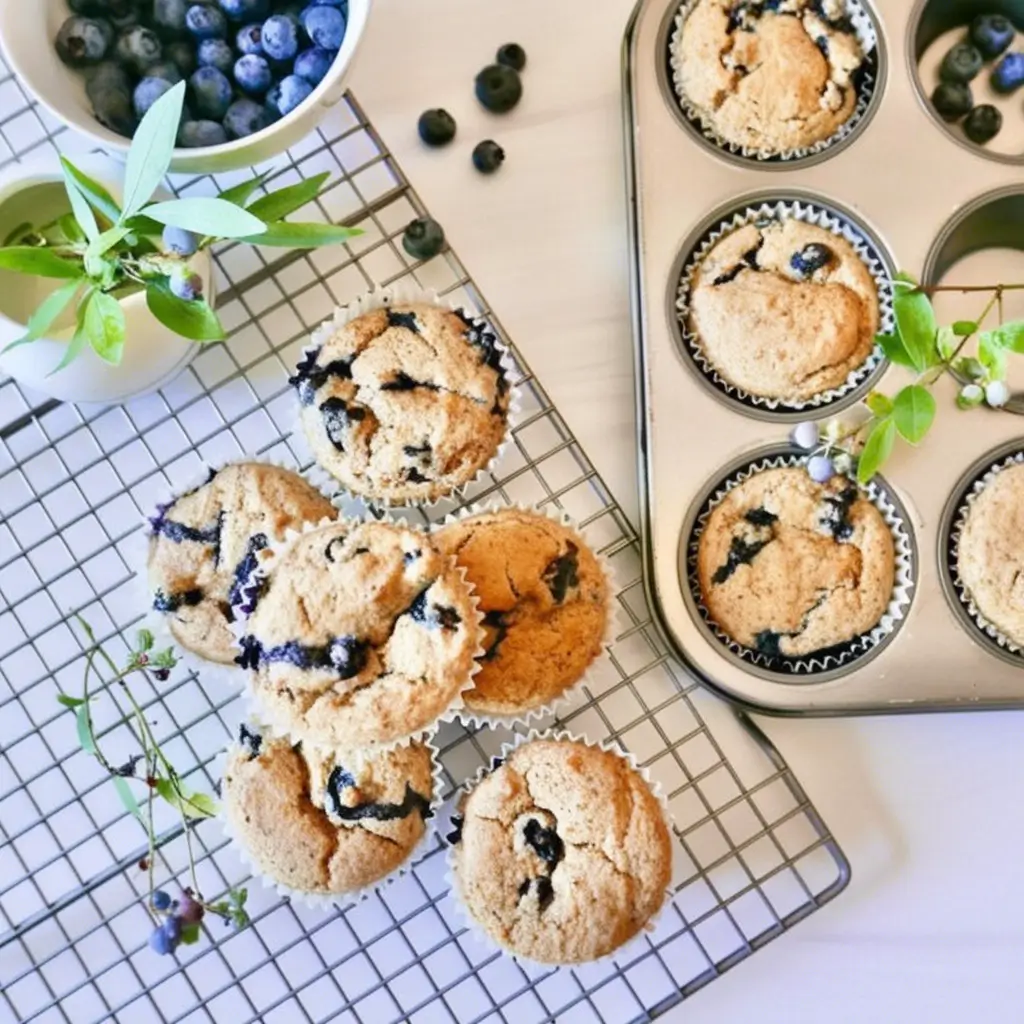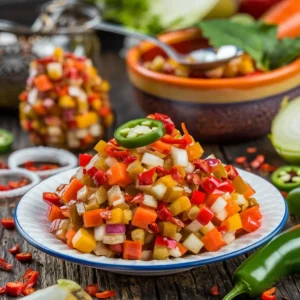Introduction: A Journey Through Gluten-Free Baking
When life gives you fresh blueberries, the possibilities are endless. While enjoying them as a healthy snack or sprinkling them over morning oatmeal are delightful options, there’s something magical about transforming these little blue gems into warm, comforting muffins. This comprehensive guide will take you through everything you need to know about creating perfect gluten-free blueberry muffins, including both classic and vegan variations.
The History of Gluten-Free Baking
The gluten-free baking journey began in the 1940s when Willem-Karel Dicke, a Dutch pediatrician, first established the connection between celiac disease and wheat consumption. Since then, the evolution of gluten-free baking has been remarkable:
- 1950s: First commercial gluten-free products appear
- 1970s: Development of early gluten-free flour blends
- 1990s: Improvement in texture and taste
- 2000s: Explosion of gluten-free options and better understanding of alternative flours
- Present: Advanced techniques and ingredients creating products indistinguishable from traditional baked goods
Understanding Gluten-Free Flours
Base Flours
- Rice Flour
- White rice flour: Light texture, neutral taste
- Brown rice flour: More nutrients, slightly grainy
- Sweet rice flour: Excellent binding properties
- Alternative Grain Flours
- Millet flour: Light, slightly nutty
- Sorghum flour: Sweet, mild flavor
- Quinoa flour: High protein, slightly bitter
- Oat flour: Sweet, creamy texture (ensure certified gluten-free)
- Nut and Seed Flours
- Almond flour: Moist, tender crumb
- Coconut flour: Highly absorbent, sweet
- Sunflower seed flour: Nut-free alternative
Starches
- Potato starch: Light, fluffy results
- Tapioca starch: Chewy texture, good binding
- Arrowroot: Similar to tapioca, more digestible
- Cornstarch: Helps with structure
Essential Ingredients for Success
Binding Agents
- Xanthan Gum
- Usage rate: 1/4 tsp per cup of flour
- Purpose: Mimics gluten’s elasticity
- Alternative: Guar gum
- Psyllium Husk
- Natural fiber
- Creates excellent structure
- Better for yeast breads
Leavening Agents
- Baking powder
- Baking soda
- Proper ratios for best rise
Classic Gluten-Free Blueberry Muffins
Ingredients:
For the Muffins:
- 2 cups gluten-free all-purpose flour blend
- 2 teaspoons baking powder
- 1/2 teaspoon baking soda
- 1/4 teaspoon xanthan gum (omit if your flour blend contains it)
- 1/2 teaspoon salt
- 2/3 cup granulated sugar
- 2 large eggs, room temperature
- 1 cup milk (dairy or non-dairy)
- 1/3 cup vegetable oil or melted butter
- 2 teaspoons vanilla extract
- 1 1/2 cups fresh or frozen blueberries
- Zest of one lemon (optional)
For the Topping:
- 2 tablespoons turbinado sugar
- 1/4 teaspoon ground cinnamon
Instructions:
- Preheat your oven to 375°F (190°C). Line a 12-cup muffin tin with paper liners or grease well.
- In a large bowl, whisk together the gluten-free flour, baking powder, baking soda, xanthan gum (if using), and salt.
- In a separate bowl, combine sugar, eggs, milk, oil or melted butter, and vanilla extract. Mix until well combined.
- Gradually add the wet ingredients to the dry ingredients, stirring until just combined. Be careful not to overmix.
- Gently fold in the blueberries and lemon zest (if using).
- Mix the topping ingredients in a small bowl.
- Divide the batter evenly among the prepared muffin cups, filling each about 3/4 full.
- Sprinkle the cinnamon-sugar topping over each muffin.
- Bake for 20-25 minutes, or until a toothpick inserted into the center comes out clean.
- Let cool in the pan for 5 minutes before transferring to a wire rack to cool completely.
Vegan Gluten-Free Blueberry Muffins
Ingredients:
- 1/4 cup ground flaxseeds
- 1 cup oat milk
- 1 cup millet flour
- 1/2 cup gluten-free oat flour
- 1/2 cup almond flour
- 1 tablespoon baking powder
- 3/4 cup coconut oil, melted
- 1/4 cup maple syrup
- 1/4 cup fresh orange juice
- 2 tablespoons vanilla paste (or 1 tablespoon vanilla extract)
- 1/2 teaspoon sea salt
- 1 1/2 cups fresh blueberries
Instructions:
- Preheat your oven to 375°F (190°C) with love and anticipation.
- Begin by creating your flax egg: combine ground flaxseeds with oat milk in a small bowl. Let it sit for 10 minutes until it thickens and becomes gel-like.
- Meanwhile, whisk together your dry ingredients: millet flour, oat flour, almond flour, and baking powder. Ensure there are no lumps – we want perfectly smooth muffins!
- In a separate bowl, combine your wet ingredients: melted coconut oil, maple syrup, orange juice, vanilla, and salt. Whisk until they’re dancing together in harmony.
- Add the thickened flax mixture to your wet ingredients and stir to combine.
- Pour your wet mixture into the dry ingredients, folding gently until just combined. Remember, overmixing is the enemy of tender muffins!
- Fold in those beautiful fresh blueberries with care.
- Divide the batter among your muffin cups – an ice cream scoop works wonderfully for this.
- Bake for 30-35 minutes, until golden brown and a toothpick comes out clean.
- Cool the muffins on a wire rack, though it’s perfectly acceptable to sneak one while they’re still warm!

The Science Behind Perfect Muffins
Temperature Control
- Ingredient Temperature
- Room temperature eggs (or substitutes)
- Properly melted fats
- Liquid temperature considerations
- Oven Management
- Proper preheating
- Temperature calibration
- Rack position
- Heat distribution
Moisture Balance
- Liquid-to-Dry Ratio
- Standard measurements
- Adjustments for humidity
- Seasonal considerations
- Fat Content
- Role of oils and butter
- Alternative fat sources
- Impact on shelf life
Advanced Baking Techniques
Mixing Methods
- Muffin Method
- Wet into dry
- Minimal mixing
- Proper folding technique
- Creaming Method
- When to use
- Benefits and drawbacks
- Temperature considerations
Fruit Integration
- Fresh Berries
- Coating with flour
- Temperature considerations
- Size and distribution
- Frozen Berries
- Thawing vs. direct use
- Preventing color bleeding
- Adjusting bake time
Nutritional Considerations
Macro Nutrients
- Protein Content
- Sources in gluten-free flours
- Balancing proteins
- Impact on texture
- Fiber Content
- Natural sources
- Added fiber options
- Digestibility
- Fat Profile
- Healthy fat sources
- Balance for texture
- Storage implications
Micro Nutrients
- Essential Vitamins
- B-vitamin compensation
- Fortification options
- Natural sources
- Minerals
- Iron content
- Calcium sources
- Zinc and selenium
Storage and Preservation
Room Temperature Storage
- Container types
- Moisture control
- Time limits
- Best practices
Freezing Methods
- Short-term Freezing
- Proper wrapping
- Container selection
- Thawing methods
- Long-term Storage
- Vacuum sealing
- Prevention of freezer burn
- Labeling systems
Troubleshooting Guide
Common Issues and Solutions
- Texture Problems
- Too dense
- Too crumbly
- Gummy interior
- Uneven rise
- Flavor Issues
- Bitter aftertaste
- Bland taste
- Off flavors
- Balance adjustment
- Technical Problems
- Sticking to liners
- Uneven baking
- Collapsed tops
- Poor browning
Creative Variations
Seasonal Adaptations
- Summer Options
- Mixed berry
- Peach addition
- Tropical variants
- Fall Favorites
- Pumpkin spice
- Apple cinnamon
- Maple pecan
- Winter Warmth
- Cranberry orange
- Chocolate chip
- Gingerbread spice
Dietary Modifications
- Sugar Alternatives
- Natural sweeteners
- Sugar-free options
- Reduced sugar variants
- Fat Substitutions
- Oil alternatives
- Reduced fat options
- Fruit puree substitutes
Serving Suggestions
Presentation Ideas
- Breakfast Service
- Buffet arrangements
- Individual settings
- Accompaniments
- Special Occasions
- Gift packaging
- Party presentations
- Holiday displays
Complementary Items
- Spreads and Toppings
- Butter alternatives
- Fruit compotes
- Nut butters
- Beverage Pairings
- Coffee and tea
- Smoothies
- Milk alternatives
Frequently Asked Questions
Q: Can I make these muffins ahead of time?
A: Absolutely! These muffins freeze beautifully for up to 3 months. Simply thaw them overnight in the refrigerator and warm them slightly before serving.
Q: How do I know when the muffins are perfectly baked?
A: Trust your senses – the muffins should spring back when lightly touched, have a wonderful aroma, and a toothpick inserted into the center should come out clean.
Q: Can I use frozen blueberries instead of fresh?
A: Yes, you can use frozen blueberries. Just be sure to thaw them first and pat them dry to prevent excess moisture in the batter. You may need to adjust the baking time slightly.
Q: Are these muffins nut-free?
A: The classic recipe contains almond flour, but the vegan version can be made nut-free by substituting sunflower seed flour or additional oat flour.
Conclusion
Creating perfect gluten-free blueberry muffins is an achievable goal with the right knowledge, ingredients, and techniques. Whether you choose the classic recipe or the vegan variation, these muffins prove that gluten-free baking can be both delicious and satisfying. Remember that practice makes perfect, and don’t be afraid to experiment with different variations to find your perfect recipe.
Resources and Further Reading
Books and Publications
- “Gluten-Free Baking Classics” by Annalise G. Roberts
- “The How Can It Be Gluten Free Cookbook” by America’s Test Kitchen
- “Gluten-Free on a Shoestring” by Nicole Hunn
Online Resources
Product Recommendations
- Bob’s Red Mill Gluten-Free Flours
- Pamela’s Baking & Pancake Mix
- Xanthan Gum by Authentic Foods
Remember, the key to successful gluten-free baking lies in understanding your ingredients and techniques. With practice and patience, you’ll be creating perfect muffins that everyone will enjoy, regardless of dietary restrictions.



